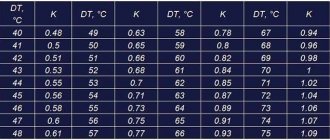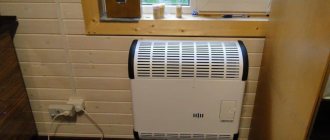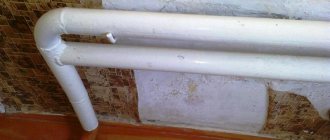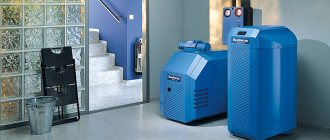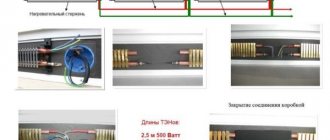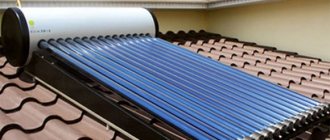Modern convectors suit any interior
Convector heating of a house is a system in which heating occurs by convection. This heat transfer process is carried out due to the movement of air currents. The simplest example of natural convection is heating water in a kettle, where the hot liquid rushes upward and the cold liquid falls down to ensure uniform heating.
A striking example of forced convection is a fan. It drives cold air currents through a heated coil and distributes heat in the required direction. Heat transfer by convection is convective exchange.
Heating a house with convectors has high efficiency and rapid heat distribution. In a short period of time, the room acquires a comfortable temperature. This system is the fastest to heat.
Concept of convector heating
First, it is necessary to outline the range of equipment and systems related to this concept. From the name it is clear that in our case we are talking about heating using air heaters - convectors. We will proceed from this, since there is a broader concept - convection heating. It includes almost all existing types of heating systems.
In simple terms, a convector radiator is a device that heats air directly. After all, heat can spread in a room in two ways:
- convection: receiving a portion of heat from the heater, the air loses density and becomes lighter, as a result of which it is forced under the ceiling by a colder and heavier flow. A slow circular circulation of air masses occurs in the room;
- infrared radiation: a surface whose temperature is above 60 ° C, or a special emitter emits infrared heat, heating all objects in the room.
The design of all types of convectors is designed in such a way as to heat only the air; the share of infrared radiation is very small and does not exceed 10% of the total amount of heat generated.
Modern heating systems for private houses, apartments and cottages use convector batteries of 3 groups:
- water;
- electrical;
- gas.
Each group includes many different devices used in certain conditions. In many ways, these conditions depend on the presence in the house of a certain energy carrier, whose use is most beneficial to the homeowner. As you might guess, the listed types of heaters differ from each other in the way they produce thermal energy to transfer it to the room.
Rules for proper operation
Only adult users who have carefully studied the manual and operating recommendations can turn the gas convector on and off and adjust its operating modes. It is unacceptable for the younger generation or incapacitated people to participate in these processes. If it is impossible to protect the gas convector from their interference, then it is better to refuse to install the device in advance.
The room in which the gas convector is planned to be used must be ventilated, which requires the presence of a window or at least a vent. It is advisable that the door leaf have ventilation grilles
Remember that if a specific gas smell is detected in the room, the tap at the entrance to the convector should be closed immediately. Under no circumstances should you “spark” in such a situation: strike matches, turn on the lights, use a lighter, etc. If these requirements are not followed, a seemingly small leak can cause a devastating explosion.
The room in which a leak was discovered must be immediately ventilated by opening the windows and door wide. You should immediately call the employees of the gas organization that connected your device to the centralized mains, or the emergency service. It will be possible to operate the gas heater only after the leak has been completely eliminated or the device has been repaired.
Water heaters
This group of heating devices is characterized by the fact that they do not produce heat on their own. Water convectors serve only as a transmission link between the boiler plant and the air masses in the building. The boiler consumes energy and produces heat, which is delivered to the heaters using the coolant - water.
Such convector heating of a private house should not be confused with radiator heating. The fact is that radiators have a fairly high share of infrared radiation, much more than 10%. Therefore, it would be incorrect to classify them as convectors.
A striking example of a water convector is a coil made of a steel pipe with plates mounted on it, which is still found today in apartments of multi-storey residential buildings. Sometimes you still come across devices hidden by a casing. In principle, this heater well reflects the general concept of direct air heating. Vertical thin plates heat the air passing through them well and at the same time emit a little radiation, since their area is too small. And devices covered with a casing emit very little radiation in the infrared range.
Nowadays, convector heating systems with wall-mounted appliances are quite rare. The reason is that wall-mounted water convectors are not so easy to find; they have been completely replaced by various radiators. Nevertheless, the following types of water air heaters are available on the market:
- baseboards;
- in-field.
The first are modules with a finned heat exchanger made of copper or aluminum. The design is classic: plates installed on pipes with coolant. The element is small in size and is placed inside an aluminum casing with air slots. The modules are mounted around the perimeter of the room instead of baseboards.
Similar convector-type heating is made on the basis of in-floor heaters. Here, a classic finned heat exchanger is built into a housing with a grille instead of a top cover. The device for increasing heat transfer is often equipped with a turbine-type fan. The product is completely hidden in the floor, only the grille through which air circulates is visible.
The main advantage of this kind of systems is versatility, because the coolant can be heated using any fuel or electricity. In this case, efficiency and work should be assessed by the efficiency of the boiler, depending on its type and the fuel used. As for the rate of heating of rooms, it is quite high, and heat consumption can be easily regulated. Another thing is that the cost of convector heating and its installation is quite high, and operating costs depend on the type of energy carrier.
Convector device
To organize convective exchange, it is necessary to use a convector. This device can operate using both natural and forced circulation. Modern convectors for heating a home can be of different designs, but they are based on three main elements:
- a heat exchanger or heating element that acts as a heat source;
- casing;
- a convection chamber with louvers or valves (it is designed to direct air flow).
Convector device
Additional elements may include devices for adjusting the direction of warm and cold air flows, as well as an automated control system.
Electric heaters
This group of heating devices independently produces heat by converting electricity. The heart of the device is the same finned heat exchanger, only inside it, instead of pipes with water, a heating element is installed. The element is placed inside a metal case, where slots are made in the lower and upper parts for air passage. The electric convector is automated from the very beginning, since even the cheapest version is equipped with a thermostat that controls the operation of the heating element.
It should be noted that heating with electric convector heaters is not only convenient, but also effective. The efficiency of the devices reaches 98%, and a high degree of automation allows you to save electricity, this is achieved by programming the heater for different operating modes at certain times of the day. According to their design, electrical appliances are:
- wall-mounted;
- floor (mobile);
- baseboards;
- intra-field.
For reference. Several convectors can be combined into a common system controlled from one center, for example, a remote programmable unit with a thermostat.
If you study all the reviews about such heaters, the negative is expressed only in one respect: it is expensive to pay for electricity. Otherwise, there are very few complaints, which is not surprising, because the price of the equipment and its installation is quite affordable for a wide range of buyers. There are also no problems with the heating speed; any convectors are famous for this.
Main advantages
The use of technologies that make it possible to increase the efficiency of a heater without increasing the amount of fuel burned has opened up new opportunities for manufacturers of heating devices. A convection oven for home or industrial premises has some key advantages that allow it to attract the attention of consumers.
- Independence from electricity (with the exception of electric convectors) is in demand among residents of suburban areas that experience long-term power outages. Indeed, in the most difficult conditions, a metal stove can be heated with almost any type of fuel. The only recommendation is not to use plastic products or any paraffin-containing materials, as this can lead to premature cleaning of the chimney.
- Uniform heating not only affects the degree of comfort, but also reduces the time it takes to warm up the room. Today there is no more effective phenomenon than convection. Therefore, this type of heat transfer is used twice: when transferring energy to cold air and when distributing heated air throughout the room.
- Convection ovens are one of the few types of devices that allow you to effectively control and regulate the intensity of combustion.
- The possibility of using long-burning technology increases the interval between adding fuel portions to ten hours.
Good to know: How to build a baby brick oven, from foundation to masonry
The list of positive qualities is not exhaustive, since the task was to identify precisely the distinctive features of the design.
Gas apparatus
In terms of the cost of equipment and its installation, gas convection heaters are in the middle between electric and water appliances. Their main problem is difficulties connecting to the gas mains or organizing fuel supply from propane cylinders. Otherwise, these are good devices for heating a private house or cottage, where people stay periodically and there is a risk of freezing the equipment or coolant in winter.
Essentially, the heater is a small convection boiler that burns natural and liquefied gas. Its heat exchanger, which is also a closed-type combustion chamber, also heats the air directly, and the heat exchange rate can be increased using a blower fan. Flue gases are emitted outside through the wall, and combustion air is taken from there through a coaxial pipe.
Installation in a private house
The ease of installation of electric convectors allows you to implement this procedure yourself.
Before you make convector heating with your own hands, you need to prepare the following tools:
- Hammer.
- Screwdriver.
- Hammer.
- Level.
A wall-mounted electric convector is installed in the following sequence of operations:
- Assembling the device, during which it is necessary to secure all the brackets to the body.
- Fitting the structure to the wall surface: it must be leveled. During this, marks are made at the location of the brackets.
- The brackets must be removed from the panel and attached one by one to the applied markings. This makes it possible to mark points for drilling holes for fasteners.
- Using a hammer drill, holes are made in the marked places.
- Using a hammer, carefully hammer the dowels into the base.
- To screw the brackets, use a screwdriver or screwdriver.
- The instrument panel is hung on well-fixed brackets.
- To start operating the convector, it must be connected to the network.
Choosing your unit
What should we teach you about choice, dear reader, if you yourself know perfectly well the standard set of conditions?
Desires must correspond to possibilities - no one has yet canceled this rule.
Experts advise paying attention to the brand of the product and the obligatory visual “fitting” of the future purchase to suit your interior and the size of the room - you will not be happy with an inexpensive purchase if you notice that the floor heating convector (aka mobile) is too small and does not have the necessary power in order to heat the room efficiently. And here, don’t take it with you – it won’t help and won’t warm you up.
Power, design, installation method, energy consumption - everything should suit you in your newly acquired heat source. And then you will be happy with your purchase and feel comfortable in your home.
Tweet
Fence for a summer residence: which one to choose?
Custom-made furniture according to individual sizes
Roller blinds for plastic windows, photo in the interior
(Visited 377 times, 1 visits today)
Warm floor
Home owners use heated water floors with their own hands, in two versions.
Warm floors evenly warm the room, increase the level of comfort and do not require additional energy costs, since the batteries and the floor circuit are powered from one boiler.
Self-installation of floors is quite accessible to owners who have carefully studied the principle of operation and the procedure for calculating heated floors. Before installation, you need to decide and purchase the necessary materials and components for the heated floor. During the installation of the circuit, strictly follow the rules and recommendations of specialists.
Ways to create a heated floor
In principle, a warm floor can be created in an apartment located in a multi-story building. But usually connection to the heating system is prohibited. If there is permission, then connection will require an examination of the influence of heated floors on the operation of the system. Typically, this design requires the installation of a separate pump and mixing unit. These additional elements will maintain system pressure at the outlet. In private houses, heated floors and a do-it-yourself heating system in a private house are inextricably linked.
The most popular methods of installing heated floors:
Pipes used for heated floors
To organize a heated floor, mainly three types of pipes are used. The best option is metal-plastic pipes, which are relatively cheap, easy to install and durable. Copper pipes are used, but they are very expensive, as well. They are inconvenient to work with because they are rigid, but they are not afraid of freezing and are easily repaired.
Principle of operation
Heat enters the room thanks to the convection method, when warm air flows from a heated heater. The gas convector is equipped with a special sealed combustion chamber; it is its surface that heats up during gas combustion.
The convection method is based on the fact that warm air coming from a heat source, being lighter, rises upward. Cold air (heavier) falls down the room and comes into contact with the convector, heats up and rises. Thus, thanks to the continuous circulation of the flow, all the air in the room is heated.
To increase the efficiency of a gas convector and heat a room of any size with maximum quality, a fan heater is built into some units. It forcibly accelerates convection, and this, in turn, significantly reduces the time to heat the room to the required temperature.
Scheme and principle of operation of a gas convector
What is an economizer and why is it needed?
Convector chimney is a heat exchanger made of high-alloy heat-resistant steel, installed directly on the pipe of a heating boiler or sauna stove and used to increase the heating rate of the main space and effectively supply warm air to adjacent rooms.
The use of an economizer is preferable if the fireplace is regularly used as the main heating device. In this case, the device will be able to take over the function of radiator heating, significantly increasing the efficiency of the entire heating system. Maximum efficiency in the operation of a chimney-convector can be achieved by installing it on the pipe of a solid fuel boiler.
Convector-type chimneys are effective for organizing heating in bathhouses. In such cases, models are used with the ability to block convection channels in order to direct all the energy generated by the fireplace to quickly warm up the steam room.
